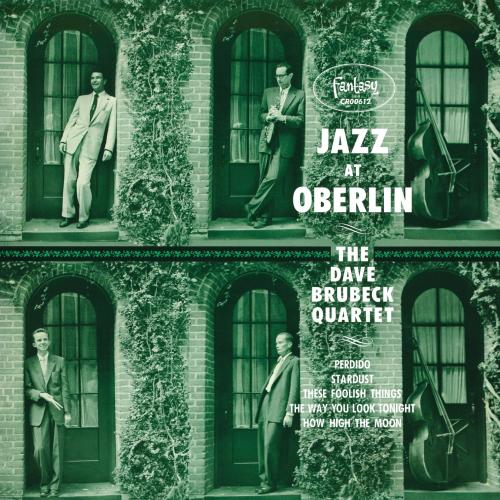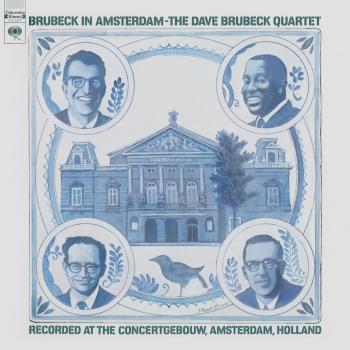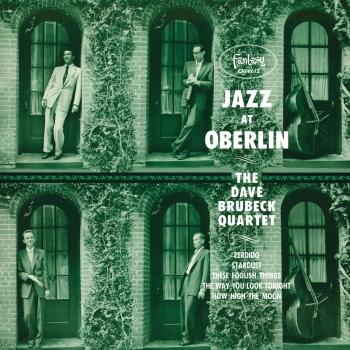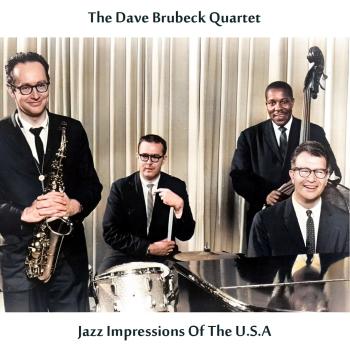
Jazz At Oberlin (Live At Oberlin College / 1953 (Mono Remastered)) The Dave Brubeck Quartet
Album info
Album-Release:
1953
HRA-Release:
10.11.2023
Album including Album cover
I`m sorry!
Dear HIGHRESAUDIO Visitor,
due to territorial constraints and also different releases dates in each country you currently can`t purchase this album. We are updating our release dates twice a week. So, please feel free to check from time-to-time, if the album is available for your country.
We suggest, that you bookmark the album and use our Short List function.
Thank you for your understanding and patience.
Yours sincerely, HIGHRESAUDIO
- 1 The Way You Look Tonight (Live At Oberlin College / 1953) 07:51
- 2 How High The Moon (Live At Oberlin College / 1953) 09:11
- 3 These Foolish Things (Live At Oberlin College / 1953) 06:33
- 4 Perdido (Live At Oberlin College / 1953) 07:46
- 5 Stardust (Live At Oberlin College / 1953) 06:30
Info for Jazz At Oberlin (Live At Oberlin College / 1953 (Mono Remastered))
Jazz at Oberlin was recorded in the Finney Chapel at Oberlin College in March 1953. It is known as one of the early works in the “cool jazz” stream of jazz by departing from bebop and even hinting at free-jazz piano techniques. It is also credited as the performance that pushed Oberlin and other colleges to legitimize jazz as a serious area of musical and intellectual study.
Brubeck's 1953 live album showed that jazz didn't have to follow the bebop route, and that there was even a chart audience out there for it
The pianist and composer Dave Brubeck had more than his share of Great Moments: he was the first to sell a million copies of a jazz instrumental; he was one of Time magazine's rare jazz cover subjects; he has played for presidents and popes; composed everything from classic jazz themes to symphonies; and the tune of his most famous hit, Take Five, is familiar to music lovers, from eight-year-olds to octogenarians.
Brubeck's first Great Jazz Moment is one that has been overlooked though – the making of his quartet's 1953 live album, Jazz at Oberlin. Not only did this dynamic gig reveal Brubeck's vivacious creative relationship with west coast alto saxophonist Paul Desmond to a new and youthful audience, confirming the then 29-year-old Desmond as a sensational sax improviser, it also indicated new directions for jazz that didn't slavishly mirror bebop, and even hinted at free-jazz piano techniques still years away from realisation. The significance of Jazz at Oberlin didn't stop with the music either. The enthusiasm of the college audience, audible throughout the album, marked Brubeck's eager adoption by America's (predominantly white) youth – a welcome that soon extended around the world, and brought the pianist chart hits for a rhythmically intricate instrumental jazz in a period in which the newly emerged rock'n'roll was carrying all before it.
What came to be known as Brubeck's "classic quartet" (comprising of Desmond, bassist Eugene Wright and the astonishing polyrhythmic drummer Joe Morello) was still three years away when the Oberlin concert was recorded, though drummer Ron Crotty and bassist Lloyd Davis played the show with brisk empathy. At the same time the repertoire – variations on standard songs or bop anthems – gave no hint as to Brubeck's subsequent fascination with adventurous but very catchy time-signatures like 5/4 and 9/8, not to mention his adaptations of classical forms like rondos and fugues. Oberlin did, however, open a window on the core creative relationship that would soon ignite all those elements (Take Five was a collaboration, developed by Brubeck from a Paul Desmond theme), and revealed a wealth of harmonic and rhythmic references in the leader's own playing that would change the language of jazz.
"Although a touch underrated, Jazz at Oberlin is one of the early Dave Brubeck classic recordings. The interplay between the pianist-leader and altoist Paul Desmond on "Perdido" borders on the miraculous, and their renditions of "The Way You Look Tonight," "How High the Moon" and "Stardust" are quite memorable. Brubeck's piano playing on "These Foolish Things" is so percussive and atonal in one spot as to sound like Cecil Taylor, who would not emerge for another two years. With bassist Ron Crotty and drummer Lloyd Davis giving the Quartet quiet and steady support, Brubeck and Desmond were free to play at their most adventurous. Highly recommended." (Scott Yanow, AMG)
Dave Brubeck, piano
Paul Desmond, alto saxophone
Lloyd Davis, drums
Ron Crotty, bass
Digitally remastered
Please Note: we do not offer the 192 kHz version of this album, because there is no considerable or audible difference to the 96 kHz version!
Dave Brubeck
designated a “Living Legend” by the Library of Congress, was one of the most active and popular musicians in both the jazz and classical worlds. With a career that spanned over six decades, his experiments in odd time signatures, improvised counterpoint, polyrhythm and polytonality remain hallmarks of innovation.
Born into a musical family in Concord, California — his two older brothers were also professional musicians — he began piano lessons with his mother at age four. He was 12 when his father moved the family to a cattle ranch in the foothills of the Sierras. Dave’s life changed dramatically. Piano lessons ended and cowboy life began. He worked with his father on the 45,000 acre cattle ranch. When he was 14, he started playing in local dance bands on weekends. When he enrolled at the College of the Pacific, in Stockton, California, his intention was to study veterinary medicine and return to the ranch. While working his way through school as a pianist in local nightclubs, the lure of jazz became irresistible and he changed his major to music. Graduating in 1942, he enlisted in the Army, and shortly thereafter married Iola Whitlock, a fellow student at Pacific. While serving in Patton’s Army in Europe, he led a racially integrated band. After his discharge from military service in 1946, he enrolled at Mills College in Oakland, California to study composition with French composer, Darius Milhaud. Milhaud encouraged him to pursue a career in jazz and to incorporate jazz elements into his compositions. This cross-genre experimentation with like-minded Milhaud students led to the formation of the Dave Brubeck Octet in 1947. In 1949, Brubeck with Cal Tjader and Ron Crotty, fellow Octet members, cut their first award-winning Dave Brubeck Trio recordings. After suffering a near fatal diving accident in 1951, Dave formed the Dave Brubeck Quartet with alto saxophonist Paul Desmond, who was also a member of the Octet. The legendary Brubeck-Desmond collaboration lasted seventeen years and beyond.
The Dave Brubeck Quartet’s recordings and concert appearances on college campuses in the ‘50s and early ‘60s introduced jazz to thousands of young people. The Quartet’s audiences were not limited to students, however. The group played in jazz clubs in every major city and toured in package shows with such artists as Duke Ellington, Ella Fitzgerald, Charlie Parker, Dizzy Gillespie, and Stan Getz. The Dave Brubeck Quartet repeatedly won top honors in trade magazines and critic’s and reader’s polls. In 1954 Dave Brubeck’s portrait appeared on the cover of Time Magazine with a story about the jazz renaissance and Brubeck’s phenomenal ascendancy.
In 1958 the Quartet made their first of many international tours. The U.S. State Department sponsored the Quartet’s performances in Poland, India, Turkey, Sri Lanka, Afghanistan, Pakistan, Iran and Iraq. Exposure to many different cultures was reflected in the group’s repertoire that sometimes incorporated exotic elements. The 1959 recording “Time Out” experimented in time signatures beyond the usual jazz 4/4. To everyone’s surprise “Time Out” became the first jazz album to sell over a million copies and “Blue Rondo a la Turk” and “Take Five” (now in the Grammy Hall of Fame) began to appear on jukeboxes throughout the world.
Early in his career Brubeck wrote primarily for this Quartet, and some of those pieces, such as “In Your Own Sweet Way” and “The Duke” became part of standard jazz repertoire. His first orchestral composition, “Elementals“, written for an improvising jazz combo and symphony orchestra was premiered and recorded in 1962. Choreographed by Lar Lubovitch, “Elemental Brubeck” is currently in the repertoire of the San Francisco Ballet and several other dance companies.
Throughout his career Brubeck experimented with integrating jazz into classical forms. In 1959 his Quartet premiered and recorded his brother Howard’s “Dialogues for Jazz Combo and Orchestra” with the New York Philharmonic, Leonard Bernstein conducting. In 1960 he composed “Points on Jazz” for the American Ballet Theatre, and in later decades composed for and toured with the Murray Louis Dance Company. His musical theater piece “The Real Ambassadors” starring Louis Armstrong and Carmen McRae was recorded and performed to great acclaim at the 1962 Monterey Jazz Festival.
The “classic” Dave Brubeck Quartet (Paul Desmond, alto sax from 1951; Eugene Wright, bass from 1958; Joe Morello, drums from 1956) was dissolved December 1967. Baritone saxophonist Gerry Mulligan joined a newly formed Dave Brubeck Trio (with Jack Six, bass and Alan Dawson, drums) the following year. This group recorded and toured the world together for seven years. In this period Brubeck also performed with three of his musical sons, Darius, Chris and Dan billed as “Two Generations of Brubeck” frequently with Gerry Mulligan or Paul Desmond as guest artists. ...
This album contains no booklet.












